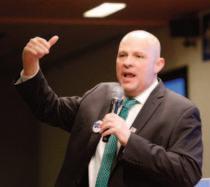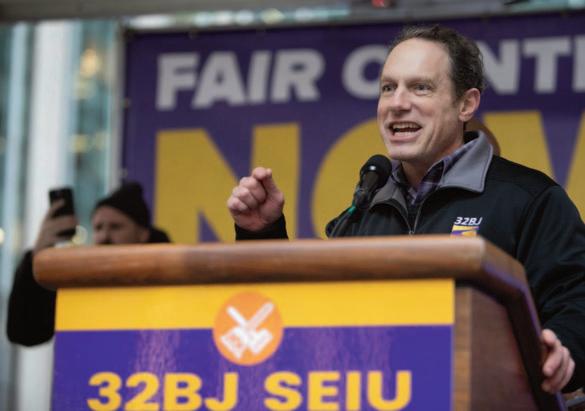


FThe new wage, which went into effect on Monday and will increase $19.96 an hour by 2025, accounts for workers’ costs of operating, including vehicle and insurance costs.
Because the apps classify delivery workers as independent contractors and not employees, they are not currently entitled to a standard minimum wage. The city’s tens of thousands of delivery workers previously earned an estimated $11 hourly on average.
For the workers organizing under the banner of Los Deliveristas Unidos, a group of mostly








York, NY : On December 20, an estimated 10,000 32BJ SEIU members rallied at 6th Ave & 50th St. to demand that the Realty Advisory Board agree to a new contract for 20,000 commercial cleaners, porters and handypersons across the city that includes fair wage increases, fully employer-paid health care for families and no


Many migrants, after being released from government custody, resettle in interior communities. These individuals and families often need immediate

December 2023 INSIDE Tips Tricks Dampen Delivery Worker Celebration of New $18-an-Hour Wage Hot Topics and News You Should Know About Issue #51 The Holidays can be a Time to Reflect and Find Meaning in Loss ...21 What Are the True Costs of Selling a Home? Let's Take a Look ...12 NYS Healthcare Workers Raise Alarms on Staffing Crisis ...5 Paralegals Have an Excellent Employment Outlook ...20 AG James Secures $10,000 for Dance Company Workers ...9 Teachers Union Sues Mayor Adams to Stop Budget Cuts ...7 Gratitude and Hope: Celebrating the Strength of AFT ...3 Labor -Related News - Nationally & Locally continued on page 13 Brian Figeroux, Esq. continued on page 4 continued on page 10 Potential Strike Authorized For 20,000 NYC Commercial Cleaners Dealing with a New Mother-in-Law ...19
ood delivery workers in New York City are now earning a mandated minimum $17.96 an hour before tips, following months of unsuccessful legal challenges by delivery platforms DoorDash, Uber and Grubhub. But a sudden coinciding move by the affected apps to change how customers can tip is taking money back out of their pockets, the workers say — and the city’s labor enforcement agency says it’s reviewing the situation. BY KEN HUDSON, IMMIGRATIONIMPACT.COM BY CLAUDIA IRIZARRY APONTE THE CITY New
Credit: lev radin / Shutterstock.com Editorial credit: a katz Shutterstock.com States Facing Worker Shortages Are Helping Migrants Secure Employment with New Resource Clinics Editorial credit: OogImages Shutterstock.com Editorial credit: 32BJ SEIU A food delivery guy deliver food using bicycle at Times Square with mask, Midtown, Manhattan, USA Editorial credit: CHOONGKY / Shutterstock.com Do You Eat With Your Eyes, Your Gut or Your Brain? ...16 Should I File for Bankruptcy Before or After the Holidays? ...12
NYC Food Delivery Workers’ Rights
If you do restaurant deliveries for an app, you have rights regardless of your immigration status.
Your Rights
Free insulated food delivery bag after 6 deliveries Apps must give you a bag. You can decide whether to use it.
More control over your deliveries
• You can limit how far you will go from restaurants and pick which bridges or tunnels you will use.
• Apps cannot offer you trips outside the limits you set, and you have the right to change your limits.
Advance notice of delivery details
Apps must tell you the pickup address, estimated time and distance for trip, tip, and pay before you accept a trip.
Better access to restaurant bathrooms when you pick up orders
Exceptions apply. Contact DCWP.
More information about your pay
Apps that take customer orders directly must tell you how much the customer tips for each delivery and your total pay and tips for the previous day. Exceptions apply. Contact DCWP.
Payment at least once a week
Apps cannot charge a fee to process your payment.
Minimum pay rate (Effective 1/1/2023)
New York City will set a minimum pay rate and may update it from time to time.
No Retaliation
It is illegal to punish or deactivate workers for exercising their rights. Workers should immediately contact DCWP about retaliation.
File a Complaint
The Department of Consumer and Worker Protection (DCWP) enforces the law. For more information or to file a complaint:
• Visit nyc.gov/DeliveryApps
• Email OLPS@dcwp.nyc.gov
• Call 311 (212-NEW-YORK outside NYC) and ask for “Delivery Worker”
DCWP will not share your identity without your prior consent.
You can also file a case in court. However, you cannot have a complaint with DCWP and a claim in court at the same time.
This information is brought to your courtesy of THE ASK THE LAWYER Radio Program For a legal consultation on these and other issues, please call 855-768-8845 or schedule an appointment at www.askthelawyer.us
www.workersworldtoday.com Dec 2023 2
Workers’ World TodayDec 2023

Supports Workers’ World Today
Recently, I was in Albany fighting and seeking support of A1261/S1947, legislation that will create a clear definition of public work and level the playing field for New York’s contractors.
District Council 9 Painters and Allied Trades Union (DC9), the union for painters, prides itself on being a strong advocate for workers’ rights and safety. We are excited about this new publication, Workers’ World Today, which covers the issues of relevance and concern for all workers. We are encouraged that all workers: blue and white collar will have a voice and platform.
Congratulations on your inaugural issue. We wish much success to the leaders and team of Workers’ World Today and pledge our support.p
Davon Lomax Political Director, DC9
Gratitude and Hope: Celebrating the Strength of AFT
BY RANDI WEINGARTEN
As I reflect on this year, I am so grateful for AFT members and allies like you. You make a difference in people’s lives every day, through all of life’s ups and downs. We’re still feeling the effects of the COVID-19 pandemic, the nation’s mood is anxious, the world is embroiled in two hot wars, and the forces of division and fear are everywhere. But there are many hopeful signs: Inflation is down, and the economy is stronger and stronger, even if we don’t always feel it. The value of unions is clear—from the successful strikes by auto workers, actors and writers to our new members in the 81 colleges, K-12 schools, libraries, hospitals and other work sites who have joined the AFT this year.
I’m with AFT members in their workplaces every chance I get, and I could not be prouder of our union and members. Solving problems, finding solutions, caring, fighting, showing up—that’s what AFT members do.
In America’s public schools and colleges, educators and school staff connect with students, hone their skills and knowledge, and help them thrive.
In our hospitals and other healthcare settings, AFT

healthcare members strive to provide high-quality, safe, patient-centered care.
At all levels of government, AFT members deliver public services that support our communities and keep them safe, healthy and vibrant.
The AFT’s campaigns put our priorities and values into action. Our Real Solutions for Kids and Communities campaign is taking on learning loss, loneliness and literacy challenges by pressing for solutions like community schools and hands-on learning. Our Code Red campaign focuses on securing safe patient limits and supporting health professionals. Through the AFT’s Reading Opens the World campaign, we have given away more than 2 million books. And our work to help AFT members reduce or eliminate their student debt is on
track to provide nearly $400 million in savings for our members.
While there’s a lot of noise, particularly on social media, communities are with us. This November, pro-public education candidates were elected up and down the ballot. And a teacher—an AFT member—is the newly elected mayor of Chicago.
As we head into the new year, let’s remember that is what unions do: We fight for a better life for our kids, families and communities. And we come together to accomplish things that would be impossible alone.
Thank you for standing with us. I wish you and yours happy holidays and a wonderful New Year!p
Randi Weingarten is the President of the American Federation of Teachers (AFT).

Chris


TEAM Publisher Workers’ World Today, Inc Editor-in-Chief Pearl Phillip Contributing Writers Linda Nwoke Victoria Falk Travis Morales
Campbell Janet Howard JR Holguin
Mary
Tobias
Telesford Legal Advisor Brian Figeroux, Esq. Telephone 1-866-435-3286 Email info@workersworldtoday.com Visit us at www.workersworldtoday.com
Erin
In Solidarity www.workersworldtoday.com Dec 2023 3
REAL ESTATE AGENTS WANTED: APPLY NOW! It's time to make a career choice that you will LOVE. Send your resume to info@ equitysmartrealty.com
Randi Weingarten Editorial credit: OogImages / Shutterstock.com
Workers’ Rights
Tip Tricks/ continued from page 1
Indigenous Latino and immigrant delivery workers, the change marked a hard-fought achievement in the works since the depths of the pandemic.
“It brings me immense pride and joy,” Sergio Ajche, a delivery worker who founded the WhatsApp group in 2020 that became Los Deliveristas Unidos, said on Wednesday.
“Three years ago I could only hope for this moment. This is a tremendous change, and it shows that anything is possible.”
At a celebration held at the NYC Central Labor Council’s midtown Manhattan headquarters, delivery workers, flanked by mayor Eric Adams, touted the historic victory, which makes New York is the first major U.S. city to establish pay minimums in the gig delivery economy.
“This is a historical moment — don’t downplay it,” Adams told the Deliveristas, adding that this was more than a victory in the courts. “You won the case, the fight to say across this entire country: People deserve to be paid the wages they
deserve.”
But this week at least two major companies have responded to the new New York City standards by overhauling how their apps process tips.
Doordash now only provides a tipping option after a customer’s order and payment are completed and a delivery person has been assigned. And Uber Eats now only offers a tipping option after the food has been delivered to a customer.
Customers were previously allowed to tip as soon as they placed their orders for delivery — an amount that, by law, must be shown to workers before they accept an order.
Workers say their tips have already plummeted to near nil. The city agency in charge of enforcing the law, the Department of Consumer and Worker Protection (DCWP), is looking into the apps’ new tipping practice, said commissioner Vilda Vera Mayuga.
“We certainly don’t endorse that — people should pay as they wish,” said Mayuga in response to questions from THE CITY.

‘Productivity Gains’
The pay scale is mandated by a 2021 local law, part of a package aimed at boosting delivery workers. Among other measures, it requires restaurants to provide restroom access on demand.
The legislation was inspired by the Deliveristas’ organizing and reporting by THE CITY, which in 2020 first exposed the challenges delivery workers face on the job, from low pay to harassment, assault, injury and death.
When the law went into effect Monday, DoorDash and Uber notified customers and workers via the app that they were overhauling their tipping practices — a move several workers and advocates who spoke with THE CITY charged was retaliatory.
“It’s bittersweet — this is a huge victory for us, but to see the companies take this position, it’s disappointing. Workers are complaining that they’re hustling but not getting tips,” said Toño Solís, a delivery worker and organizer, who said the companies’ move felt like “a form of revenge.”
Added Solís: “The companies have played with us long enough — this proves why we cannot let our guard down.”
DoorDash now tells its customers at checkout that the changes were happening “in response to” the new law in New York City, while Uber says its change is “as a result of” the law.
Asked by THE CITY to clarify their claim, both companies referred to a section in a 2022 DCWP study of the industry designed to set the wage scale, which includes changes to tipping as one scenario companies might pursue to offset any additional costs of higher wages.
“Policies have consequences, and these changes come as a direct result of the extreme earnings standard imposed in New York City,” said DoorDash spokesperson Eli Scheinholtz, who added the move helps the company “balance the impact” of the law on workers, customers and merchants.
Uber spokesperson Josh Gold said the company moved to overhaul its tipping practices to incentivize workers to work harder: “The city’s emphasis on productivity gains to achieve the minimum wage will force couriers to do more deliveries — this is one way to start to do that.”
Grubhub is the only one of the three major platforms that has not overhauled its tipping model, but it reduced the range for suggested tips upon checkout to 0-10% from the 1025% it had presented to customers as recently as Monday, a change the company made only in New York City.
A spokesperson for the DCWP condemned the changed tipping procedures.
“This is entirely Uber and DoorDash’s own business decision,” the spokesperson, Michael Lanza, told THE CITY. “DCWP supports customers having the option to tip whatever amount they would like, and we do not endorse this nor have we suggested the apps change their tipping policy.”
Ajche said that some customers have begun to share their frustrations about not being able to tip upon checkout on the apps. Some have resorted to tipping in cash or via Venmo and other forms of payment, he said. “To the companies, I would say — this is making you look bad, these games you’re playing.”p
Article first published in THE CITY on December 06, 2023. Reprinted with permission. Reprinted with permission.
www.workersworldtoday.com Dec 2023 4
Delivery workers make the rounds in lower Manhattan, Dec. 5, 2023.
Credit: Ben Fractenberg/THE CITY
NYS Healthcare Workers Raise Alarms on Statewide Staffing Crisis, Demand Legislative Action to Strengthen Workforce, Patient Care in FY25 State Budget
NEW YORK, N.Y.:
Healthcare workers with the New York State Nurses Association (NYSNA) and Communications Workers of America District 1 (CWA D1), joined by other healthcare unions and labor leaders, held a rally and press conference this morning calling on lawmakers to prioritize safe staffing, ahead of a crucial state legislative hearing on healthcare priorities for the FY25 state budget. At the hearing, healthcare workers from hospitals across the state will share testimonies underscoring the impact that pervasive understaffing has had on worker safety and the quality of care their communities receive.
Just an hour before the hear-
ing commenced, workers from hospitals all over the state united to ensure safe staffing was top of mind for New York legislators heading into the hearing, where they’d determine the future of the state’s strained healthcare system. With patients’ lives on the line, healthcare workers urged lawmakers to prioritize proposals that support the workforce as well as hospital funding, following years of widespread recruitment and retention challenges that have left healthcare workers around the state to deal with dangerous nurse-to-patient ratios.
Assemblywoman Latoya Joyner (D-Bronx, 77th AD), chair of the Assembly Labor Committee, joined workers at the rally and said, “New York's

healthcare system has been under extraordinary stress since being impacted by the COVID-19 pandemic and much of the workforce remains stretched far too thin.
Focusing on how to improve working conditions for those who provide care for our friends, family and neighbors, our joint public hearing will help us enhance the healthcare
services provided in our state.” Assemblywoman Aileen Gunther (D-100), chair of the Assembly Mental Health Committee also spoke at the rally, saying, “We know how important nurses are in the healthcare industry. We are demanding safe staffing because it saves lives. We have been fighting for this for years and years; we need to have this
done, and we need it done now.”
Workers called for robust implementation and enforcement of the 2021 Hospital Clinical Staffing Committee law and called on lawmakers to ensure full Medicaid reimbursement is included in the FY25 State Budget in addition to proposals aimed at stabilizing the existing healthcare workforce.
Healthcare workers with NYSNA, CWA D1 and other unions are also sharing testimonies at the hearing to highlight the human impact and severity of the staffing crisis that’s forced frontline healthcare workers to care for too many patients at once, at the expense of patient safety.
continued on page 6

Union In Action www.workersworldtoday.com Dec 2023 5
lev radin Shutterstock.com
Credit:
NYS Healthcare Workers/ continued from page 5
“There is no shortage of nurses. There is a shortage of nurses that are willing to work under the conditions we are seeing in our hospitals, our nursing homes, and home care,” said NYSNA Executive Director Pat Kane at the rally. Decades of underfunding and staffing shortages across New York have plunged the state’s healthcare workforce into crisis, requiring healthcare workers to push themselves past the point of exhaustion, working mandatory overtime with skeleton crews. Meanwhile, hospitals throughout the state are having to work with negative or unsustainable operating budgets, incentivizing the further reduction of healthcare workers, exacerbating short staffing, worsening quality of care and further destabilizing the workforce. In New York state, only 53% of actively licensed nurses are actively working as nurses, demonstrating that the State is facing more of a shortage of good healthcare jobs than healthcare workers themselves.
In her testimony, Kerry Larkin, a Registered Nurse in New York City and CWA District 1 member, said, “The recruitment and retention challenges facing hospitals across New York directly result from the deplorable conditions we are working in, primarily lack of staffing. This work environment has led to many healthcare workers leaving the profession altogether. We must improve working conditions and ensure safe staffing to bring workers back to patients' bedside where it’s needed most. If we continue with the same toxic atmosphere, we will not keep our workforce or entice those who have left to return.”
"Nurses work incredibly hard to ensure we can provide safe, quality care to every patient, regardless of zip code,” said NYSNA President Nancy Hagans, RN, BSN, CCRN. “We need New York’s hospitals and the Department of Health to work just as hard to deliver and enforce safe staffing to help us do our best. NYSNA members in every part of the state report chronic under-

staffing that compromises care and drives nurses away from the bedside. We need to change that immediately by ensuring safe staffing everywhere.”
Scheena Tannis, a Registered Nurse and 1199SEIU member who has worked at a safety net hospital in Brooklyn for 18 years, said, “We cannot solve the staffing issue without solving the healthcare funding crisis. My hospital is a safety-net institution with many patients relying on Medicaid, but the state only covers 70% of the cost of care for those patients. Medicaid patients do not only get 70% of an illness and we certainly don’t give them just only 70% of care. Everyone deserves 100%. Our elected officials have the power to close this funding gap to protect our most vulnerable and the workers who care for them.”
"There is no denying that our healthcare system is experiencing severe staffing shortages that jeopardize patient care and worker safety. That is why the union movement has prioritized addressing the statewide staffing crisis,” said Mario Cilento, President of the New York State AFLCIO. “We already know that safe staffing benefits patients, nurses, and hospitals which is why we are united in calling for fully funding Medicaid and enforcement of the safe staffing law. The lives of patients and those who care for them, depend on it."

“Patient care in New York City and across the state is at risk because hospitals are refusing to abide by the state’s 2021 Safe Staffing for Quality Care law. The Federation of Nurses/UFT was the first union in the state to bring violations of the law to the state Health Department this summer, violations against NYU Langone HospitalBrooklyn. The Federation of Nurses this month won a precedent-setting arbitration against NYU Langone Hospital- Brooklyn for short-staffing one of its medical-surgical units. For the first time, there is a financial liability if the hospital ignores contractual safe staffing ratios,” said Anne Goldman, head of the Federation of Nurses/UFT, which represents roughly 4,000 members in New York City and 16,000 in New York State. “But we need the legislature and administration to help enforce the state’s safe-staffing law, and to continue to support union efforts to hold hospital administrations accountable for meeting safe staffing ratios."
New York State Public Employees Federation President Wayne Spence, whose union represents thousands of nurses at three SUNY hospitals and facilities across the state, said, “Severe short staffing must be prioritized as both a quality of care and worker safety issue. Nurses are routinely working beyond exhaustion, and it is unsustainable. More must be done to enforce clinical staffing plans so our nurses can properly care for patients. Addressing healthcare shortages requires some of the same solutions PEF is advocating for across State agencies. New York must do a better job of recruiting and retaining its skilled healthcare workforce by improving Tier 6 of the State pension plan so professionals are incen-
tivized to make a career out of State service."
“Healthcare workers in New York are facing a crisis of understaffing that is actively undermining the quality of patient care and threatening public health,” said New York City Central Labor Council AFL-CIO President Vincent Alvarez. “These workers as well as the working families who rely on them for healthcare deserve better. The New York City Labor Movement stands in solidarity with the dedicated members of NYSNA and CWA, and call on all of our elected officials to make safe staffing and full Medicare reimbursement a priority in the next budget.”
NYSUT President Melinda Person said, “Safe working conditions are not optional, nor is their enforcement. Each day that proper staffing ratios in our healthcare facilities are ignored, lives are put at risk. The state must ensure hospitals are following the protections in law, which not only show workers the respect they deserve, but are essential to growing and maintaining the hospital workforce New York desperately needs.”
The morning’s action added to the growing momentum in New York state healthcare workers’ ongoing fight to secure safe staffing across the state. Last month, workers with CWA District 1 escalated their efforts with the submission of 8,000 violations of hospitals’ clinical staffing plans to the New York Department of Health (DOH). The plans were required by the 2021 Clinical Staffing Committee law, which both CWA District 1 and NYSNA helped write and pass to ensure safe staffing levels and quality patient care across all New York hospitals. Since it went into effect in January 2023, thousands of unresolved staffing complaints have been filed on behalf of workers by CWA D1, NYSNA, and other prominent healthcare unions to ensure the law is properly implemented and enforced. NYSNA nurses are also using the contract enforcement process, as well as filing DOH complaints, to enforce safe staffing standards. NYSNA nurses have won several arbitration awards because of staffing violations, including a $220K award from Mount Sinai and most recently an award from Montefiore Health System, proving that staffing is still a crisis all over the state, for every healthcare union.p
Union In Action www.workersworldtoday.com Dec 2023 6
Compensation Compensation for Victims & for Victims & Families of Families of Nursing Home Nursing Home Abuse and Abuse and Neglect Neglect If your loved one was neglected or abused in a Nursing Home or assisted living facility, financial compensation may be available. Call 855-768-8845 for a consultation One in six residents in nursing homes and community facilties were neglected last year resulting in thousands of families experiencing trauma, mental illness, medical emergencies, and even death. Nursing home abuse and neglect is real. Has your loved one experienced any of these or other types of abuse? •Bedsores •Improper Treatment/Medication •Choking/Death •Malnutrition/Dehydration •Falls •Respiratory Illness •Fractured Bones •Sexual Abuse •Infections •Sexual Assault Experience matters. The lawyer you hire does make a difference. Schedule a consultation now. Get compensation for your loved one’s suffering. Call 855-768-8845 or visit www.askthelawyer.us
lev radin Shutterstock.com
Credit:
Teachers Union Sues Mayor Adams to Stop School Budget Cuts
BY MICHAEL ELSEN-ROONEY CHALKBEAT
New York City’s teachers union is suing Mayor Eric Adams in an attempt to halt nearly $550 million in school budget cuts, according to legal documents filed Thursday in Manhattan Supreme Court.
Adams is violating a state law barring the city from decreasing its contribution to schools when the city’s overall revenue doesn’t go down, the United Federation of Teachers’ lawsuit argues. Revenues went up by $5 billion last year, the union claims.
The “draconian” cuts, the suit further claims, will infringe on students’ constitutional rights to a “sound basic education.”
Three teachers and a speech therapist joined the suit as plaintiffs, outlining how they lack resources and supplies for their students, especially those
with high needs.
The suit asks a judge to order the city to restore its funding of schools to last year’s levels. It is the second legal challenge from a municipal union in the last two weeks seeking to stop the cuts. DC 37, the city’s largest public union, sued over the cuts last week.
“The administration can’t go around touting the tourism recovery and the return of the city’s pre-pandemic jobs, and then create a fiscal crisis and cut education because of its own mismanagement of the asylum seeker problem,” said union president Michael Mulgrew. “Our schools and our families deserve better.”
The city’s law department didn’t immediately respond to a request for comment. Adams sought to downplay the conflict when asked about the lawsuit during an unrelated press conference Thursday morning.
“The UFT, they have to rep-
The United Federation of Teachers lawsuit argues that City Hall is violating New York State law barring the city from decreasing its contribution to schools when the city’s overall revenue doesn’t go down.

resent their members,” Adams said. “From time to time, friends disagree. Sometimes … it ends up in a courtroom.”
Lawsuit Ramps Up Pressure on
Adams
Adams has argued for months that the city is facing a fiscal crisis due to unanticipated spending on the influx of more than 150,000 migrants and asylum-seekers since last summer.
But critics of the cuts, including Mulgrew, have countered that the city is overstating how much the city will spend on the new arrivals. The administration’s claim that the city’s response to the increase in migrants will cost about $11 billion over the next two years is an “unverified estimate,” the lawsuit claims. The Independent Budget Office and the city’s comptroller’s office have pro-
jected lower costs.
The city routinely projects budget deficits that are ultimately erased plugged by higher-than-anticipated revenue, Mulgrew argued in a recent op-ed. That’s what happened last fiscal year when the city collected $8.3 billion more than projected in tax revenue, he said.
The move to file a legal challenge represents a significant escalation in the union’s efforts to reverse the cuts, which were originally announced in September and formally rolled out late last month.
Adams ordered all city agencies to find savings of 5% in the November cuts. Additional rounds of 5% cuts are expected in January and next spring, bringing the potential total
continued on page 8

Education www.workersworldtoday.com Dec 2023 7
UFT President Mulgrew Editorial credit: a katz / Shutterstock.com
Teachers Union Sues/ continued from page 7
losses to the Education Department north of $2 billion.
The November cuts, which totaled $547 million, slashed the city’s universal pre-K and 3-K programs, its free summer school program, and its community schools initiative.
Chalkbeat recently learned that the city was quietly targeting cuts in District 75 programs for students with complex disabilities. Staffers said they are facing budget cuts far greater than the $3 million reduction outlined in the November plan. People familiar with the discussions said the planned cuts in District 75 total about $97 million and could jeopardize extracurricular programs, supplies budgets, and the jobs of paraprofessionals.
Those cuts “threaten these schools and the 26,000 students, many of whom have complex disabilities” and “will exacerbate significant staffing and resource shortages,” the suit alleges.
An Education Department spokesperson previously said the agency was doing everything possible to shield schools

from the impact of the cuts, and that District 75 schools were undergoing a normal process of reconciling actual enrollment with projections.
Suit Hinges on Claims of Funding Misuse
That higher-than-anticipated revenue is at the center of one of the legal claims in the union’s lawsuit.
The suit cites a section of the state education law that “prohibits the City from reducing spending in its schools from the level provided in the preceding year unless overall City revenues decline,” according to legal documents.
The city allocated $14.5 billion to schools in last year’s budget, and $14.1 billion in
this year’s, according to the suit. That amount will fall to $13.9 billion if all the cuts go through, the union claims. Union lawyers also allege that the city is misusing a historic influx in state aid, which has increased by about $1.3 billion in recent years after the state’s fully funded the Foundation Aid formula.
Because of the city’s budget cuts, the Education Department will have to tap state funds to support programs. But state law requires the city to use any increases in state aid to “supplement” what the city is spending on education, rather than “supplant” it, the lawsuit argues — meaning that the Adams administration would be violating this provi-

sion.
Three teachers and a speech therapist also joined the lawsuit as plaintiffs, sharing their experiences to illustrate how the cuts could be in violation of a “sound basic education.”
Miriam Sicherman, a third grade teacher at Manhattan’s Children’s Workshop School, has six Spanish-speaking migrant students, four of whom are not literate even in Spanish.
Without any additional resources from the Education Department, the lawsuit claims, she is “essentially running three classes within her third-grade class to accommodate and teach the migrant children with severe educational needs alongside her other third-grade students.”
Rebecca Lopez, a teacher at P.S./M.S. 279 in the Bronx, “cannot afford basic equipment for her high-needs and disabled students or curricular materials for her class,” according to the suit.p
Michael Elsen-Rooney is a reporter for Chalkbeat New York, covering NYC public schools.
Article first published in THE CITY on December 21, 2023. Reprinted with permission.


l
l
l


Education www.workersworldtoday.com Dec 2023 8
Party Rentals for All Occasions
Bounce Houses & Slides
Fun Food Concessions
l
l
Games
Package Specials
Tent, Tables, Chairs & Other Party Essentials Call 848.999.4928 GREEN CARD SLAVERY? Don’t put up with ABUSE anymore! Whether married or not, whether your spouse is a U.S. citizen or Green Card Holder, we can get a Green Card for you and your children PLUS a divorce. Call 855-768-8845 now for a consultation! ENOUGH IS ENOUGH! To learn more or to file a complaint: Visit nyc.gov/workers Call 311 and say “Paid Safe and Sick Leave Law” COVID or a cold? You have the right to Safe and Sick Leave It’s the Law. If you work for a private employer, including as a domestic worker, you can get up to 40 or 56 hours of leave a year to care for yourself or family. For COVID-19 or other health or safety reasons. This information is brought to your courtesy of THE ASK THE LAWYER Radio Program. For a legal consultation on these and other issues, please call 855-768-8845 or schedule an appointment at www.askthelawyer.us
Attorney General James Secures $10,000 for Dance Company Workers for Unpaid Wages and Harmful Labor Practices
NEW YORK : New York
Attorney General Leti-
tia James announced that her office secured $10,000 for nine former employees of H+, a Manhattan-based dance company, for failing to pay rightfully earned wages or properly address sexual harassment claims, in violation of New York’s labor and human rights laws. An investigation by the Office of the Attorney General (OAG) found that H+ charged for dance classes entirely staffed and run by purported volunteers while the company’s leaders pocketed the funds. The OAG also found that the company’s founder and artistic director, Safi Thomas, perpetuated a hostile work environment.
“Far too often, the physical labor and sacrifice of artistic workers like dancers are overlooked, but every New York worker deserves to be paid
what they are rightfully owed,” said Attorney General James. “H+ built a stressful work environment and took advantage of hardworking artists just to pocket the profits for themselves. New Yorkers have my word: as your Attorney General, I am committed to ensuring that no one gets away with cheating hardworking people out of their fair pay or threatening their rights.”
The OAG opened an investigation after receiving a February 2021 complaint from Safe Horizon, the nation’s leading survivor assistance organization. The OAG found that H+ consistently misclassified workers as “members” or “apprentices” instead of employees so that they would not have to pay them for their labor. Profits earned from employees’ hard work directly funded the living expenses of H+’s so-called “artistic eche-

lon,” a group comprised of Thomas and three other members of H+’s leadership team who lived together in an apartment entirely funded by the company. The investigation also revealed that Thomas fostered a hostile work environment, frequently subjecting
women employees to unequal treatment and sexual harassment. Further, H+ lacked a formal process for employees to report cases of discrimination.
Under the settlement announced today, H+ will pay
$10,000 in unpaid wages to nine former employees, and Thomas will undergo individual training regarding sexbased discrimination, sexual harassment prevention, and an employer’s obligations under the law. H+ will also, among other things:
nDevelop anti-discrimination and anti-sexual harassment training protocols and complaint processes for employees and managers, and submit written materials to OAG regarding these trainings.
nEnsure new hires complete the training protocol within 30 days of the start of their employment.
nProperly classify all persons who perform work for H+ and Thomas as employees and set wages appropriate for their labor in compliance with New York wage laws.p

Workers’ Matters www.workersworldtoday.com Dec 2023 9
Attorney General James Editorial credit: lev radin / Shutterstock.com
Workers’ Matters
Potential Strike/ continued from page 1
cuts to job protections after essential cleaners demonstrated their commitment and service during the pandemic. Building workers voted to give the bargaining committee the power to call for a strike, if they decide it becomes necessary. A strike, if one occurs, would affect 1,300 buildings.
At the rally, workers were joined by leading elected officials and top labor leaders including U.S. Senate Majority Leader Chuck Schumer, Attorney General Letitia James, Mayor Eric Adams, NYC Comptroller Brad Lander, President of the New York City Central Labor Council Vinnie Alvarez, Executive Director of UAW Region 9A Brandon Mancilla, among others.
“Our members need to move forward, not backwards – they need wage increases that allow them to pay for rising rents, the rising cost of transportation, the rising cost of everything. We are demanding that we have health insurance we can count on and can afford. We are demanding pension improvements. We are going to make sure these contractors can’t attack our jobs. We have had four bargaining sessions and made zero progress. Time
is running short for the RAB to make a deal,” said 32BJ President Manny Pastreich.
“We were designated as essential workers at the start of the COVID-19 pandemic. My dad and I were forced to work despite the unknown risks at the time, because our buildings and the city needed us. My dad got COVID, and we lost him to the virus. He is fighting with me in this contract fight. When I went back to work, I was terrified of bringing the virus home to my family and two kids. The RAB wants to say our jobs are less needed than they were before COVID. Then why was I asked to work overtime at the height of the pandemic? Why did we risk our lives? What more do they want from us? We will not relinquish our dignity. We will strike if it comes to that. Give us the wages we deserve and keep your hands off our benefits and labor protections,” said Dulce Martinez, 18-year commercial cleaner (2 Broadway).
“I’m a strike captain. I’ve spent half my life as a 32BJ commercial member. And right now I am angry! The RAB proposals put our ability to take care of our families at risk. We are talking about 20,000 working families’ livelihoods at stake! More of us could be forced to move out of the city. More of us would

have to choose between our health and paying rent. More of us could be forced to take second jobs! The RAB talks about their trillions of dollars –while we’re talking about how we’re going to pay our bills,” said Godwin Dillon, 20-year commercial cleaner (85 Broad St).
“Hardworking New Yorkers deserve fair pay, good benefits, and true appreciation for their efforts. As commercial cleaners seek to secure a contract, it is important that we all recognize their invaluable contributions to our city, as well as the essential role they played during and following the COVID pandemic. I am proud to stand with these New Yorkers and support their fight for recognition and an equitable con-
tract,” said New York Attorney General Letitia James.
RAB proposals include:
nMaking members pay for their life-saving health insurance (healthcare premium sharing).
nA permanent second tier workforce that would lock in substandard wages and benefits for new hires.
nUnnecessary cuts to labor protections and fairness in the workplace that ignore how the existing contract already allows for reduction in the workforce when vacancies increase, as has been demonstrated over the last three years.
nCuts to paid sick days and vacation.
nEliminating overtime wages after 8 hours.
The RAB claims impacts to the industry during the pandemic justify gutting the existing labor contract. Their demands for “flexibility” ignore how the existing contract permitted employers to eliminate 2,000 positions to account for increased office vacancies.
Workers are fighting for their first contract since COVID and seek wage increases that keep up with the cost of living, the protection of life-saving health care benefits and other labor standards that have lifted thousands of NYC working class and immigrant families toward the middle class.
The contract covers large commercial office buildings like One Vanderbilt and World Trade Center; tourist attractions and public spaces like the Empire State Building Observatory, Top of the Rock, The Edge at Hudson Yards, World Trade Observatory; museums like MoMA; new commercial developments like Hudson Yards; universities like NYU, Pace, Long Island University and St. John’s University; transportation hubs like Grand Central, Penn Station and Port Authority; biotech labs; and more.p
Read more at www.workersworldtoday.com

www.workersworldtoday.com Dec 2023 10
Editorial credit: 32BJ SEIU
Law360 Union Walks Off the Job in One-day Action Protesting Management’s Threats, Unlawful Conduct at the Bargaining Table
NEW YORK: Unionized editorial workers at Law360 — who have had enough of parent company LexisNexis execs’ illegal tactics and stalling at the bargaining table — will hold a one-day strike on Wednesday, highlighted by a mid-afternoon rally and a day-long picket line outside corporate headquarters in New York City.
Readers of the legal news service are urged not to cross the digital picket line Wednesday.
The work stoppage comes after The NewsGuild of New York filed an unfair labor practice charge on behalf of Law360 Union against LexisNexis on Tuesday. The basis of the
Workers will hold a day-long picket line outside LexisNexis headquarters in NYC as well as a mid-afternoon rally in support of the ULP walkout.
charge is a Nov. 16 bargaining session in which LexisNexis representatives threatened Guild members with less favorable terms the longer negotiations continue. Regressive bargaining is a form of bad faith bargaining, in which one side moves backwards, offering less on a proposal than they had previously offered.
“Instead of working today, we are gathering together, refusing to work and standing up for a fair contract,” said Hailey Konnath, a reporter for the LexisNexis-owned legal news site and unit chair for the union. “LexisNexis needs to
understand that we will not back down and today they will see that in full effect as we picket outside their headquarters.”
Contract negotiations between the union, which represents nearly 300 workers, and LexisNexis began on Nov. 17, 2022. The union’s current contract expired on Dec. 31, 2022.
For more than a year, management has refused to respond (either at all, or meaningfully) to proposals including sick time, parental leave, paid time off, and retirement.
“Law360 Union members
work hard to make the company a success and LexisNexis needs to recognize their contributions with good faith proposals that meaningfully address our concerns,” said Susan DeCarava, President of The NewsGuild of New York. “Anything less is unacceptable and will lead to further labor strife.”
Walkout Details
Workers will march in a daylong picket line beginning at 10:30 a.m. outside LexisNexis headquarters at 230 Park Ave. in Manhattan. At 2 p.m, the Guild will hold a rally on the

north side of the building on 46th Street featuring speakers including NewsGuild-CWA President Jon Schleuss, NewsGuild of New York President Susan DeCarava and members of the Law360 Union. Throughout the walkout: Law360 members at offices around the country will gather via Zoom.p

Workers’ Rights www.workersworldtoday.com Dec 2023 11
Editorial credit: JHVEPhoto / Shutterstock.com
What Are the True Costs of Selling a Home? Let's Take a Look
BY EQUITY SMART REALTY INC
Are you thinking about selling your house? Before you decide to list your home up for sale, it is helpful to get a clear picture of how much it's going to cost. Whether you are sprucing things up with a fresh coat of paint, replacing the roof membrane or just covering your taxes, there will be a few bills to pay. Let's take a quick look at some of the true costs that you'll incur when selling your home.
Is Your Home Ready to Sell?
The first question you will need to answer is whether your home is ready to sell. Unless your house is relatively new, it will likely need repairs and maintenance. Depending on the age and condition of your home, you may also decide to invest in a full home inspection. Having a professional inspector look things over is a good invest-

ment – especially if they find problem areas that require immediate attention.
Invest In A Good Real Estate Agent (And Their
Commission)
To get the best price for your home, you will need to be represented by a great real estate agent. Of course, they are not going to work for free. Once the home sells, the agent is compensated with a percentage of the sale price, which is known as a commission. In some cases, the home seller also pays the commission for the buyer's real estate agent as well.
Factor In Costs During the Sales Process
The selling process will also have its costs. From lawyers' fees to excise taxes, there is no shortage of small costs that can start to add up. You may decide to invest a bit in your open houses to make them more welcoming. Or you might need to close out your mortgage. Whatever the case, be sure to leave some space in your budget for these costs.
Moving Out Will Cost You Too
Finally, don't forget to factor in the cost of moving to your new home. Many families fail to budget for moving expenses,

which can be significant if you are moving out of a large home with a lot of furniture.
Guidance
As you can see, selling a home is a major financial transaction and one that should be led by an experienced professional. When you are ready to begin the process of selling your home, give us a call. Our team of real estate professionals can advise you of local market conditions and ensure that you receive top dollar when you sell.
For more tips and advice about selling your home, contact our professional real estate team today. We are happy to help. Call us 888-670-6791.p



Be Equity Smart www.workersworldtoday.com Dec 2023 12 26 Court Street, Suite 701, Downtown Brooklyn Call 888-670-6791 Minorities continue to be the target of the predatory practices by real estate and mortgage brokers and the man who comes knocking on your door with a bag of cash. To save your home, call us now for a consultation at 855-768-8845. Call Equity Smart Realty at 888-670-6791 for a consultation.
Worker Shortages continued from page 1 support in the form of housing, food, and clothing, frequently lack documentation from their country of origin, and have limited understanding of their immigration status in the United States.
Many come ready and eager to work. But one of the primary barriers preventing them from doing so and achieving self-sufficiency in the short term is lack of work authorization.
Some migrants are eligible to apply for a work permit upon arrival – like those admitted into the U.S. through the parole processes for nationals of Cuba, Haiti, Nicaragua, and Venezuela (CHNV) – while many others must first submit an asylum application and wait a subsequent minimum of 150 days before applying for work authorization. And due to processing delays that have plagued USCIS for years, many of them have to wait far longer before they are formally granted permission to work lawfully in the U.S.
In the face of these chal-
lenges, communities across the country, ranging from New York City to Denver, are stepping up to help migrants address barriers to work authorization. While cities are on the front lines of this welcoming effort, state governments have a key role to play in marshaling resources and coordinating multi-sector partners involved in the response. States like Massachusetts, Illinois, New York, and New Jersey – all of which have Offices of New Americans – have invested resources to help migrants apply for work authorization and other legal status. One innovative model that states are pursuing is resource clinics. These clinics bring together local, state, and federal government agencies along with legal and direct service providers to create a one-stop style event where new arrivals can receive free legal advice and support with submitting their Application for Employment Authorization.
With record-low unemployment rates across the country and employers struggling to find workers in key industries,
Workers’ Safety

the benefits of work authorization go far beyond the individual and are shared among the broader community.
Beyond the sheer coordination required to stand up and staff these events, a unique feature has been the involvement of federal government partners on-site, including staff from U.S. Citizenship and Immigration Services (USCIS) and the Department of Homeland Security (DHS). The presence of federal agency staff means eligible migrants can complete an application and have it processed at the same location, cutting down on unnecessary processing delays and back-and-forth.
Here are some examples of
how states are helping migrants apply for work permits and other relief:
How Massachusetts Is Helping Migrants
The Massachusetts Office for Refugees and Immigrants hosted a clinic in November, leveraging National Guard volunteers as well as a National Guard facility in Reading, MA. The event aimed to address traditional barriers faced by new arrivals by providing transportation from shelters facing overcrowding and language interpretation, in addition to legal services. USCIS and DHS provided support to accept and process applications at the event.
How Illinois Is Helping Migrants
Illinois is taking a multi-tiered approach to address barriers to work authorization while also dealing with limited shelter capacity difficulties in Chicago and throughout the state.
With winter approaching, Governor Pritzker announced $30 million in state funds to establish an intake center and $65 million to set up a tent base camp which will house an additional 2,000 migrants. The state hopes to curtail migrants being dropped by buses from the border in the streets of Chicago and coordinate a more humanitarian, comprehensive approach. The state has also invested $65 million for other wrap-around services, including legal assistance required to provide migrants with access to work authorization.
How New York Is Helping Migrants
New York, the most heavily impacted state to date, has undertaken an exhaustive effort to help the new arrivals, many of whom are Venezuelan, apply for Temporary Protected continued on page 14

www.workersworldtoday.com Dec 2023 13
Old & New Immigrants: Their Rights
Worker Shortages
continued from page 13
Status (TPS). If granted, TPS provides work authorization and renewable lawful status.
Since October, the state, in collaboration with local and federal partners, has helped submit 5,500 work authorization and TPS applications statewide through a surge of personnel and resources, including National Guard corps, legal services, nonprofits, and additional caseworkers at NYC Health + Hospitals, a network of health services that accept individuals regardless of immigration status or their ability to pay. With New York City alone receiving over 140,000 migrants since spring 2022, there remains a profound need for even more of these services and resources.
How New Jersey Is Helping Migrants
The New Jersey Department of Human Services (where the state’s Office of New Americans is housed) and the New Jersey Department of Labor and Workforce Development collaborated to invest $2.5 million in federal funds to raise
awareness about the work authorization application process and provide application support. The agencies also launched web portals to match new arrivals looking for work with employers with job opportunities.
Over the next few months, the Department’s Office of New Americans will develop outreach, education, and application assistance efforts to reach immigrants who are immediately eligible to apply for a work permit.
Overall, despite many challenges with an immigration system that causes backlogs, delays, and gaps for individuals struggling to resettle here, state governments, in collaboration with local and federal partners, have identified work authorization as the key to success for new arrivals and the communities where they reside. Together, these partners are actively seeking solutions, fostering partnerships, and connecting migrants to the resources they need to begin contributing to their communities.p
Read more at www.askthelawyer.us
USCIS Changes Filing Location for Requests for Premium Processing for Pending Immigrant Petitions for Alien
U.S. Citizenship and Immigration Services (USCIS) announced today a change in the filing location for Form I-907, Request for Premium Processing, for currently pending Form I-140, Immigrant Petition for Alien Workers, as part of efforts to increase efficiency by reducing USCIS’ footprint at the service centers and reducing costs related to Service Center intake of Forms I-140 and I-907. This change in filing location also allows USCIS to centralize digitization of the forms for downstream electronic adjudication. This is being done in three phases.
Important Information
USCIS previously announced that effective Nov. 13, 2023 (phase 1), the filing location for Form I-907 filed together with Form I-140 has changed from the service centers to the USCIS lockboxes. As a re-

minder, starting on or after Dec. 13. 2023, USCIS will reject any Form I-907 filed with Form I-140 that is received at the previous service center address.
For phase two, on Dec. 15, 2023, the filing location for Form I-907 requesting premium processing of a currently pending Form I-140, will change from the USCIS service centers to the USCIS Lockbox.
This change in filing location does not apply if you are filing Form I-140 with an associated application (such as Form I485, Form I-765, Form I-131). At this time, the lockboxes will reject any Form I-907 filed with a Form I-140 that has an asso-
ciated Form I-485, Form I-131, or Form I-765. USCIS will soon announce filing location changes for these forms, but at this time, they should continue to be filed with the service centers, as listed on the Direct Filing Addresses for Form I-140, Immigrant Petition for Alien Worker page.
In addition, we remind filers to follow the guidance on submission of documents to USCIS to reduce processing delays. See Tips for Filing Forms by Mail.
NOTE: Receipt notices from the lockbox will show an IOE code for your receipt number instead of an LIN or SRC code.p

www.workersworldtoday.com Dec 2023 14
Editorial credit: Sundry Photography / Shutterstock.com
Should I File for Bankruptcy Before or After the Holidays?
BY JANET HOWARD
Bankruptcy helps people who can no longer pay their debts get a fresh start by liquidating assets to pay their debts or by creating a repayment plan. Bankruptcy laws also protect financially troubled businesses. Filing bankruptcy can help a person by discarding debt or making a plan to repay debts. A bankruptcy case normally begins when the debtor files a petition with the bankruptcy court. A petition may be filed by an individual, by spouses together, or by a corporation or other entity.
It may seem like there is never a good time to file for bankruptcy, but with the holidays sneaking up on us, it may seem like now is one of the worst times. If you're struggling financially, money can be the last thing you want to think about during a time dedicated to family and celebration.
However, filing for bankruptcy before the holiday can have its perks.
If you're considering waiting to file for bankruptcy until after the holidays are over, here are a few reasons you may want to change your mind.
1. You don't need to worry about overspending. If you're already struggling with debt, you may want to file for bankruptcy before you do your holiday shopping. By completing the paperwork before you shop, you will be limited on the amount you spend on gifts — preventing you from falling deeper into debt. Many individuals believe that they will be able to erase their holiday expenses if they wait to file. Unfortunately, this isn't always the case and more often than not you're left paying a credit card bill you can't afford.
Keep yourself — and your spending — in check by filing


for bankruptcy before the holidays begin.
2. You won't stress (about money) while spending time with family. When spending time with friends and family over the holidays, you don't want your mind to be elsewhere. If you're waiting until after the holidays pass to file for bankruptcy, you may find your mind wandering to what the process will look like, if you'll be able to file, or how much your attorney will cost.
Filing for bankruptcy before the holidays means you can get the process started and your questions answered before your family and friends stop by. When you aren't worrying about the bankruptcy process, you can enjoy your time with the ones that you love.
3. Your gifts and bonuses won't chance your bankruptcy filing. One of the best parts about the holidays is giving and receiving gifts. You may even be ex-
pecting a large bonus from your employer or a monetary gift from your parents, grandparents, aunts, uncles, or other family members.
Unfortunately, these gifts and bonuses can influence your income, potentially making bankruptcy filing more difficult. Because each chapter of bankruptcy has salary limitations or requirements, a gift or bonus may push you over that amount and you will no longer be able to file for that chapter.
If you file before those gifts or bonuses are given, they will not influence your income.
Filing for bankruptcy can be confusing no matter what the time is. But when it comes to the holidays, you can get it out of the way before your busy schedule begins. If you're debating filing for bankruptcy, you may want to seriously consider finding time to submit the paperwork before the holidays begin.p


The Law Offices of Figeroux & Associates, 26 Court Street, Suite 701, Brooklyn, NY. Visit www.askthelawyer.us GET YOUR BANKRUPTCY CONSULTATION Documents Required: *List of debts *Your most recent tax returns *Correspondence from creditors *Lawsuit documents *Social Security and ID *List of assets Save Your: *Home *Health *Business *Peace of Mind/Health *Car *Marriage/Relationship Filing a Chapter 7, 11 or 13 bankruptcy may be your only choice!!! Get the legal help you need NOW! Call 718-222-3155! The Law Offices of Figeroux & Associates, 26 Court Street, Suite 701, Brooklyn, NY. Visit www.askthelawyer.us Creditors’ Harassments! Lawsuits! Foreclosures! Call 855-768-8845 for a consultation today! Money Matters www.workersworldtoday.com Dec 2023 15
Do You Eat With Your Eyes, Your Gut or Your Brain? A Neuroscientist Explains How to Listen to Your Hunger During the Holidays
BY ALEX JOHNSON THE CONVERSATION
The holiday season is upon us, and with it, opportunities to indulge in festive treats. The proverbial saying “you eat with your eyes first” seems particularly relevant at this time of year.
The science behind eating behavior, however, reveals that the process of deciding what, when and how much to eat is far more complex than just consuming calories when your body needs fuel. Hunger cues are only part of why people choose to eat. As a scientist interested in the psychology and biology that drives eating behavior, I’m fascinated with how the brain’s experiences with food shape eating decisions.
So how do people decide when to eat?

Eating with your eyes
Food-related visual cues can shape feeding behaviors in both people and animals. For example, wrapping food in McDonald’s packaging is sufficient to enhance taste preferences across a range of foods –from chicken nuggets to carrots – in young children. Vi-
sual food-related cues, such as presenting a light when food is delivered, can also promote overeating behaviors in animals by overriding energy needs.
In fact, a whole host of sensory stimuli – noises, smells and textures – can be associated with the pleasurable con-

sequences of eating and influence food-related decisions. This is why hearing a catchy radio jingle for a food brand, seeing a television ad for a restaurant or walking by your favorite eatery can shape your decision to consume and sometimes overindulge.
However, your capacity to
learn about food-related cues extends beyond just stimuli from the outside world and includes the internal milieu of your body. In other words, you also tend to eat with your stomach in mind, and you do so by using the same learning and brain mechanisms involved in processing food-related stimuli from the outside world. These internal signals, also called interoceptive cues, include feelings of hunger and fullness emanating from your gastrointestinal tract.
It’s no surprise that the signals from your gut help set the stage for when to eat, but the role these signals play is more profound than you might expect.
Trust your gut Feelings of hunger or fullness
continued on page 17






Love, Health & Travel www.workersworldtoday.com Dec 2023 16
particular stressors of the holiday season can make it difficult to listen to your body. Looking for a quality touch for your altered or custom made clothing? COMPETENT | RELIABLE | EXPERIENCED CALL US TODAY 347 837 0404 OUR EXPERTISE: •Men & Women Clothing •Pants Hemming •Jacket Alterations •Formal Attire Alterations •Dress & Gown Alterations •Pants, Skirts & Blouse Alterations •Custom Tailoring and more
The
Listen to Your Hunger continued from page 16
act as important interoceptive cues influencing your decision-making around food.
To examine how interoceptive states shape eating behaviors, researchers trained laboratory rats to associate feelings of hunger or satiety with whether they receive food or not. They did this by giving rats food only when they were hungry or full, such that the rats were forced to recognize those internal cues to calculate whether food would be available or not. If a rat is trained to expect food only when hungry, it would generally avoid the area where food is available when it feels full because it does not expect to be fed.
However, when rats were injected with a hormone that triggers hunger called ghrelin, they approached the food delivery location more frequently. This suggests that the rats used this artificial state of hunger as an interoceptive cue to predict food delivery and subsequently behaved like they expected food.
Interoceptive states are sufficient to shape feeding behaviors even in the absence of

external sensory cues. One particularly striking example comes from mice that have been genetically engineered to be unable to taste food but nevertheless show preferences for specific foods solely by caloric content. In other words, rodents can use internal cues to shape their food-related decision-making, including when and where to eat and which foods they prefer.
These findings also suggest that feelings of hunger and the detection of nutrients is not restricted to the stomach. They also involve areas of the brain important for regulation and homeostasis, such as the lat-
eral hypothalamus, as well as centers of the brain involved in learning and memory, such as the hippocampus.
What happens in vagus
The gut-brain axis, or the biochemical connection between your gut and your brain, shapes feeding behaviors in many ways. One of them involves the vagus nerve, a cranial nerve that helps control the digestive tract, among other things.
The vagus nerve rapidly communicates nutrient information to the brain. Activating the vagus nerve can induce a pleasurable state, such that mice will voluntarily perform
a behavior, such as poking their nose through an open port, to stimulate their vagus nerve. Importantly, mice also learn to prefer foods and places where vagal nerve stimulation occurred.
The vagus nerve plays an essential role in not only communicating digestive signals but also an array of other interoceptive signals that can affect how you feel and behave. In people, vagal nerve stimulation can improve learning and memory and can be used to treat major depression.
Benefits of interoceptive awareness
Your body’s capacity to use both external and internal cues to regulate how you learn and make decisions about food highlights the impressive processes involved in how you regulate your energy needs.
Poor interoceptive awareness is associated with a range of dysfunctional feeding behaviors, such as eating disorders. For instance, anorexia may result when interoceptive signals, such as feelings of hunger, are unable to trigger the motivation to eat. Alternatively, the inability to use the feeling of fullness to dampen the rewarding and pleasurable
consequences of eating palatable food could result in binge eating.
Your interoceptive signals play an important role in regulating your daily eating patterns. During the holidays, many stressors from the outside world surround eating, such as packed social calendars, pressures to conform and feelings of guilt when overindulging. At this time, it is particularly important to cultivate a strong connection to your interoceptive signals. This can help promote intuitive eating and a more holistic approach to your dietary habits. Rather than fixating on external factors and placing conditions on your eating behavior, enjoy the moment, deliberately savor each bite and provide time for your interoceptive signals to function in the role they are designed to play.
Your brain evolved to sense your current energy needs. By integrating these signals with your experience of your food environment, you can both optimize your energetic needs and enjoy the season.p
Alex Johnson is an Associate Professor of Behavioral Neuroscience, Michigan State University

Love, Health & Travel www.workersworldtoday.com Dec 2023 17
Your senses feast on food as much as your stomach does.

Workers’ World TodayDec 2023 www.workersworldtoday.com Dec 2023 18
Dealing with a New Mother-In-Law
BY MARY CAMPBELL
As a newlywed, one of the first things that will soon become a reality for you, is the adage of “you don’t marry one person, you marry and entire family.” In that regard, this may apply more to a new mother-in-law, rather than other extended family members. After all, you have now become the one that your spouse is probably going to rely on more than their mother.
Nevertheless, dealing with a new mother-in-law, in spite of many scripted opinions and perceptions, does not need to be much different than any other extended family relationship. Like most relationships, they need to be developed, nurtured, and build on a foundation of trust and respect.
In fact, and contrary to popular belief, most mother-in-law motives are based on a desire and willingness for the new marriage of their son or daugh-

ter to be successful. That being said, here are some suggestions for you to consider in dealing with your new motherin-law that may help offset any potential marital anxiety.
Take the Lead in Establishing the Relationship
Being proactive, and taking the lead in establishing a relationship with your mother-in-law will probably be well received and appreciated. For example,
initiating occasional phone conversations and family gettogethers, beyond the normal holiday events, are a couple of ways that can enhance the relationship. Additionally, not only should this raise your credibility level, it could also pave the way in forming other extended family relationships.
Reach Out for Advice and Counsel
The fact of the matter is, in
dealing with real life challenges and experiences over the years, your mother-in-law has probably acquired a significant amount of wisdom. As is the case in all new marriages, there will be times when problems will arise with no apparent solution in sight. More than likely, since your motherin-law probably has encountered the same type of problems that you may face, she can be an excellent resource. By reaching out, and seeking advice on certain issues, not only can provide a solution, but will also foster the relationship.
Be Sensitive to Your Spouse’s Relationship with Their Mother
It is imperative that you are sensitive and respectful to the relationship between your spouse and their mother. Without question, although it may sometimes become difficult, there never should be any negative comments made to
your mother-in-law regarding your spouse. Likewise, the same situation applies with your spouse concerning your mother-in-law. Even the slightest criticism can cause substantial and irreparable damage.
It’s Okay to Say No
More often than not, there will be occasions when you are simply too busy to accept an invitation or even to answer the phone. Although, at times, it may require some courage, it’s okay to decline, as long as it is done respectfully, pleasantly, and in some instances, smilingly. Besides, there is nothing wrong with ensuring that demands are not placed on you.
In short, by utilizing these suggestions in dealing with your new mother-in-law, can help develop a relationship that will be mutually beneficial and, equally important, reduce or eliminate any marital anxiety. p

Love, Health & Travel www.workersworldtoday.com Dec 2023 19
855-768-8845
Aspiring Paralegals Enjoy an Excellent Employment Outlook
BY FREEPARALEGAL.ORG
Some individuals considering various career possibilities are troubled when they hear about technological advancements eliminating jobs because of automation and artificial intelligence. Many occupations are not easily automated, though. Attorneys, for example, hire support staffers to manage a broad range of duties. This allows the lawyers to focus on more complicated tasks. They hire paralegals as well as clerical staff. A person can start a paralegal career by completing the educational requirements. People who are interested in the law and legal work may find this job an ideal fit.
Employment Outlook
Law firms employ most paralegals. Others find work with large corporations and government agencies, such as with a district attorney’s office or the
Social Security Administration.
The U.S. Bureau of Labor Statistics (BLS) expects rapid growth in the occupation until at least 2031. Organizations wanting to reduce costs are hiring fewer legal clerical workers. They fill the gaps with paralegals, who can manage some of the secretarial tasks while also performing higher-level duties.
In addition, many openings occur because of men and women leaving the occupation. Many people in the workforce are reaching retirement age or choosing to retire early. Some paralegals decide to pursue further education and become lawyers.
Job Duties
Paralegals can legally do most of the work of licensed lawyers. There are only a few duties that these employees are not allowed to do by law. They cannot sign legal documents, accept cases, or counsel and
represent clients. However, they can interview clients and witnesses, draft pleadings and other documents and conduct legal research. They help attorneys with case planning and management and assist during trials.
Paralegals employed in an office that has minimized its clerical staffing perform some administrative work as well. The same is true for those employed with small law firms and solo practitioners. They may need to do word processing, spreadsheet data entry, scanning and photocopying documents, and billing clients.
Qualifications
The most common route to becoming a paralegal is completing a two-year associate degree in this field. These opportunities are provided at technical schools, community colleges, and four-year universities that offer associate degrees.
The Chamber Coalition offers an affordable online Paralegal Certificate Program. The Program is highly regarded and has existed for over ten years. Additional certificates include Lexis-Nexis and CLIO. Students have access to CALI, which is in law schools. Included are CALI, CLIO, and a Paralegal Certificate from Lexis Nexis. Visit www.freeparalegal.org
Specialties
Aspiring paralegals may decide to specialize in a certain area of the law. They might want to work for a family law firm or divorce attorney, for instance. Individuals can choose many other specialties as well, such as corporate, bankruptcy, personal injury, and immigration law.
Income
The median pay for paralegals as of 2021 was about $27 per
hour, according to the BLS. That translates to around $56,000 for those who work full-time, which is typically the case. Some receive salaries while others are paid an hourly wage. Candidates considering jobs where more than 40 hours weekly is routinely expected may prefer organizations that pay per hour unless the salary makes the average pay comparable.
Concluding Thoughts
Individuals who are interested in the law and the work of attorneys may find the career of paralegal to be an excellent choice. An excellent employment outlook means job security and a broad range of possibilities.
There are free orientations every month. The next orientation is Monday, January 8, 2024 at 6pm via Zoom.
Register at www.chambercoalition.org today.p

Jobs & Recession www.workersworldtoday.com Dec 2023 20 Orientation is Monday, Jan 8, 2024 Join us via Zoom at 6pm
For Many Who are Suffering With Prolonged Grief, the Holidays can be a Time to Reflect and Find Meaning in Loss
BY MANDY DORIA THE CONVERSATION
The holiday season is meant to be filled with joy, connection and celebration of rituals. Many people, however, are starkly reminded of their grief this time of year and of whom – or what – they have lost.
The added stress of the holiday season doesn’t help. Studies show that the holidays negatively affect many people’s mental health.
While COVID-19-related stressors may have lessened, the grief from change and loss that so many endured during the pandemic persists. This can cause difficult emotions to resurface when they are least expected.
I am a licensed therapist and trauma-sensitive yoga instruc-
tor. For the last 12 years, I’ve helped clients and families manage grief, depression, anxiety and complex trauma. This includes many health care workers and first responders who have recounted endless stories to me about how the pandemic increased burnout and affected their mental health and quality of life.
I developed an online program that research shows has improved their well-being. And I’ve observed firsthand how much grief and sadness can intensify during the holidays.
Post-pandemic holidays and prolonged grief
During the pandemic, family dynamics, close relationships and social connections were strained, mental health problems increased or worsened,

and most people’s holiday traditions and routines were upended.
Those who lost a loved one during the pandemic may not have been able to practice rituals such as holding a memorial service, further delaying the grieving process. As a result, holiday traditions may feel more painful now for some. Time off from school or work can also trigger more intense feelings of grief and con-
tribute to feelings of loneliness, isolation or depression.
Sometimes feelings of grief are so persistent and severe that they interfere with daily life. For the past several decades, researchers and clinicians have been grappling with how to clearly define and treat complicated grief that does not abate over time.
In March 2022, a new entry to describe complicated grief was added to the Diagnostic
and Statistical Manual of Mental Disorders, or DSM, which classifies a spectrum of mental health disorders and problems to better understand people’s symptoms and experiences in order to treat them.
This newly defined condition is called prolonged grief disorder. About 10% of bereaved adults are at risk, and those rates appear to have increased in the aftermath of the pandemic.
People with prolonged grief disorder experience intense emotions, longing for the deceased, or troublesome preoccupation with memories of their loved one. Some also find it difficult to reengage socially and may feel emotionally numb. They commonly avoid reminders of their loved one and may experience a loss of
continued on page 22

Conversations www.workersworldtoday.com Dec 2023 21
Photo courtesy: NYC CLC
In the post-pandemic world, many people are facing the holidays without their loved ones by their side.
Find Meaning in Loss/ continued from page 21
identity and feel bleak about their future. These symptoms persist nearly every day for at least a month. Prolonged grief disorder can be diagnosed at least one year after a significant loss for adults and at least six months after a loss for children.
I am no stranger to complicated grief: A close friend of mine died by suicide when I was in college, and I was one of the last people he spoke to before he ended his life. This upended my sense of predictability and control in my life and left me untangling the many existential themes that suicide loss survivors often face.
How grieving alters brain chemistry
Research suggests that grief not only has negative consequences for a person’s physical health, but for brain chemistry too.
The feeling of grief and intense yearning may disrupt the neural reward systems in the brain. When bereaved individuals seek connection to their lost loved one, they are craving the chemical reward they felt before their loss when
they connected with that person. These reward-seeking behaviors tend to operate on a feedback loop, functioning similar to substance addiction, and could be why some people get stuck in the despair of their grief.
One study showed an increased activation of the amygdala when showing death-related images to people who are dealing with complicated grief, compared to adults who are not grieving a loss. The amygdala, which initiates our fight or flight response for survival, is also associated with managing distress when separated from a loved one. These changes in the brain might explain the great impact prolonged grief has on someone’s life and their ability to function.
Recognizing prolonged grief disorder
Experts have developed scales to help measure symptoms of prolonged grief disorder. If you identify with some of these signs for at least one year, it may be time to reach out to a mental health professional.
Grief is not linear and doesn’t follow a timeline. It is a dynamic, evolving process that is

different for everyone. There is no wrong way to grieve, so be compassionate to yourself and don’t make judgments on what you should or shouldn’t be doing.
Increasing your social supports and engaging in meaningful activities are important first steps. It is critical to address any preexisting or co-occurring mental health concerns such as anxiety, depression or post-traumatic stress.
It can be easy to confuse grief with depression, as some symptoms do overlap, but there are critical differences.
If you are experiencing symptoms of depression for longer than a few weeks and it is affecting your everyday life, work and relationships, it may be time to talk with your primary care doctor or therapist.
A sixth stage of grief
I have found that naming the stage of grief that someone is experiencing helps diminish the power it might have over them, allowing them to mourn their loss.
For decades, most clinicians and researchers have recognized five stages of grief: denial/shock, anger, depression, bargaining and acceptance.
But “accepting” your grief doesn’t sit well for many. That is why a sixth stage of grief, called “finding meaning,” adds another perspective. Honoring a loss by reflecting on its meaning and the weight of its impact can help people discover ways to move forward. Recognizing how one’s life and identity are different while making space for your grief during the holidays
might be one way to soften the despair.
When my friend died by suicide, I found a deeper appreciation for what he brought into my life, soaking up the moments he would have enjoyed, in honor of him. After many years, I was able to find meaning by spreading mental health awareness. I spoke as an expert presenter for suicide prevention organizations, wrote about suicide loss and became certified to teach my local community how to respond to someone experiencing signs of mental health distress or crisis through Mental Health First Aid courses. Finding meaning is different for everyone, though.
Sometimes, adding a routine or holiday tradition can ease the pain and allow a new version of life, while still remembering your loved one. Take out that old recipe or visit your favorite restaurant you enjoyed together. You can choose to stay open to what life has to offer, while grieving and honoring your loss. This may offer new meaning to what – and who – is around you. p
Mandy Doria is an Assistant Professor of Psychiatry, University of Colorado Anschutz Medical Campus

Conversations www.workersworldtoday.com Dec 2023 22

lawyer you hire, does
a difference! www.workersworldtoday.com Dec 2023 23 Workers’ World TodayDec 2023
The
make


Workers’ World TodayDec 2023








































































